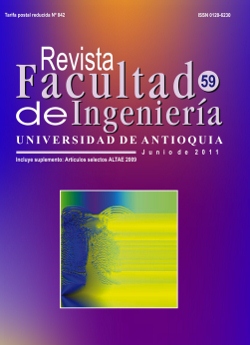Forecasting of hourly electric load in Colombia using artificial neural networks
DOI:
https://doi.org/10.17533/udea.redin.13766Keywords:
electric load, artificial neural networks, forecastingAbstract
A Neural Network based full-week hourly electric load forecasting model is proposed for Colombia. This model uses historical information delays as well as previously identified date events which produce significant changes in the electric load patrons through the year, the model also consider a three weeks delay in the available information used in forecasts. The model was validated using real electric load data from a specific Colombian region. The results were compared with an auto-regressive model (AR) and an auto-regressive model with exogenous variables (ARX). The general error decay and the good approximation during the atypical time periods, which are difficult to forecast, make it a satisfying model.
Downloads
References
J. W. Taylor, L. M. de Menezes, P. E. McSharry. “A comparison of univariate methods for forecasting electricity demand up to a day ahead”. International Journal of Forecasting. Vol. 22. 2006. pp. 1-16. DOI: https://doi.org/10.1016/j.ijforecast.2005.06.006
S. Kiartzis, C. Zoumas, J. Theocharis, A. Bakirtzis, V. Petridis. “Short-term load forecasting in an autonomous power system using artificial neural networks”. Power Systems, IEEE Transactions on . Vol. 12. 1997. pp. 1591-1596. DOI: https://doi.org/10.1109/59.627863
E. A. Mohamed, M. M. Mansour, S. El-Debeiky, K. G. Mohamed. “ Egyptian Unified Grid hourly load forecasting using artificial neural network”. International Journal of Electrical Power & Energy Systems . Vol. 20. 1998. pp. 495-500. DOI: https://doi.org/10.1016/S0142-0615(97)00052-5
K. Topalli, I. Erkmen. “A hybrid learning for neural networks applied to short term load forecasting”. Neurocomputing . Vol. 51. 2003. pp. 495-500. DOI: https://doi.org/10.1016/S0925-2312(02)00870-6
N. Mahdavi, M. Menhaj, S. Barghinia. “Short-Term Load Forecasting for Special Days Using Bayesian Neural Networks”. Power Systems Conference and Exposition, 2006. IEEE/ PES . 2006. pp. 1518-1522. DOI: https://doi.org/10.1109/PSCE.2006.296525
Z. Y. Dong, B. L. Zhang, , Q. Huang. “Adaptive neural network short term load forecasting with wavelet decompositions”. IEEE Porto Power Tech Proceedings. 2001. pp. 1-77.
W. Sun, J. Lu, Y. He. “Information Entropy Based Neural Network Model for Short-Term Load Forecasting”. Transmission and Distribution Conference and Exhibition: Asia and Pacific. 2005 IEEE/PES . 2005. pp.1-5.
M. Espinoza, J. A. Suykens, B. D. Moor. “Load Forecasting Using Fixed-Size Least Squares Support Vector Machines”. Computational Intelligence and Bioinspired Systems. Vol. 3512. 2005. pp. 1018-1026. DOI: https://doi.org/10.1007/11494669_125
G. S. Hu, Y. Z. Zhang, F. F. Zhu. “Short-Term Load Forecasting Based on Fuzzy C-Mean Clustering and Weighted Support Vector Machines”. Procudings of the Third International Conference on Natural Computation. Haikore (China). Vol. 5. 2007. pp. 654- 659.
T. Zheng, A. A. Girgis, E. B. Makram. “A hybrid wavelet-Kalman filter method for load forecasting”. Electric Power Systems Research. Vol. 54. 2000. pp. 11-17. DOI: https://doi.org/10.1016/S0378-7796(99)00063-2
H. Tabares, J. Hernández. “Pronóstico puntos críticos de la serie temporal consumo de energía eléctrica del sector industrial en la ciudad de Medellín usando algoritmos genéticos”. Rev. Fac. Ing. Univ. Antioquia. Vol. 40. 2007. pp. 95-105.
H. Tabares, J. Hernández. “Aproximación por lógica difusa de la serie de tiempo demanda diaria de energía eléctrica”. Rev. Fac. Ing . Univ. Antioquia. Vol. 47. 2009. pp. 209-217.
C. J. Franco, J. D.Velásquez, Y. Olaya. “Caracterización de la demanda mensual de electricidad en Colombia usando un modelo de componentes no observables”. Cuadernos de Administración especial de finanzas . Vol. 21. 2008. pp. 221-235.
H. S. Medina, A. J. García. “Predicción de la demanda de energía eléctrica en Colombia mediante un sistema de inferencia difuso neuronal”. Revista Energética. Vol. 33. 2005. pp. 15-24.
B. Martin, A. Sanz. Redes Neuronales y Sistemas Borrosos. 3ª. ed. Ed. RA-MA. Madrid (España). 2006. pp. 442.
Downloads
Published
How to Cite
Issue
Section
License
Copyright (c) 2018 Revista Facultad de Ingeniería

This work is licensed under a Creative Commons Attribution-NonCommercial-ShareAlike 4.0 International License.
Revista Facultad de Ingeniería, Universidad de Antioquia is licensed under the Creative Commons Attribution BY-NC-SA 4.0 license. https://creativecommons.org/licenses/by-nc-sa/4.0/deed.en
You are free to:
Share — copy and redistribute the material in any medium or format
Adapt — remix, transform, and build upon the material
Under the following terms:
Attribution — You must give appropriate credit, provide a link to the license, and indicate if changes were made. You may do so in any reasonable manner, but not in any way that suggests the licensor endorses you or your use.
NonCommercial — You may not use the material for commercial purposes.
ShareAlike — If you remix, transform, or build upon the material, you must distribute your contributions under the same license as the original.
The material published in the journal can be distributed, copied and exhibited by third parties if the respective credits are given to the journal. No commercial benefit can be obtained and derivative works must be under the same license terms as the original work.










 Twitter
Twitter